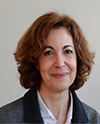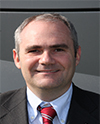The Digitalization of Distribution Systems
By Ferdinanda Ponci and Antonello Monti
The digitalization of electrical power distribution systems is evolving rapidly. In spite of the uncertainty of future roles of the distribution systems operator (DSO), the digitalization is reaching the substations, via existing standards and technologies. And it promises to invest the whole business sector, also beyond the DSOs, enabling markets and services not feasible otherwise. We provide here in a nutshell what digitalization is expected to yield, what its ways are to penetrate the distribution systems, and what factors of influence and challenges are shaping the future scenarios.
Digital data handling and digital communication are not new to the operation and management of distribution grids. Distribution System Operators (DSO) run SCADA and computer systems in control centers and substations, automation with intelligent electronic devices (IEDs) at least in medium voltage (MV) is common, and substations communicate to their control center through remote terminals units with various communication means and digital technologies. The EU Report on digitalization defines the digitalization of the energy system as, ”The process of implementing and operating a set of assets by monitoring, transferring and analyzing data which have been generated by one of the actors in the energy system.”
Building on this definition, we can extend the digitalization of DSOs to the embracing of the virtualization of their operations (technical and economical) so that the actual location of knowledge, data, computations, becomes independent from the place where knowledge data and computations are originated or performed. This scenario opens the way to:
- Modulate the deployment of hardware particularly in the substations, so that automation upgrade may mean more communication HW but less data collection, processing, and local communication. Thus the DSO may realize cost savings depending on the evolution of the costs of technology and services in these sectors.
- Purchase and offer services, so that the DSO may be able to immediately implement e.g. sophisticated optimization strategies, or big data analysis, or new customer relations, without possessing the full know-how behind the implementation of the related software (SW).
- Access data generated by others or provide its own data, e.g. to ease the cooperation with Transmission System Operators (TSO).
The digitalization of technical and business operations of the DSOs is evolving quickly. The EU report lists use cases leveraging on digitalization, taken from many current EU large projects and demonstrations. For example, the project IDE4L has produced a full automation architecture based on digitalization, which supports advanced functionalities like local state estimation in MV and LV, fault location and service restoration, cooperation of the DSO with Aggregators, TSOs and third party providers. This architecture, based on standards, particularly the standard series IEC61850, core of digital substation automation, has been successfully demonstrated in the field and it is designed to be deployed in the next decade. However, much more futuristic visions are now being explored, involving the Cloud, the Future Internet and related platforms.
First steps are the smart meter data hubs being deployed in the Nordic countries. One example is FINGRID in Finland, which realizes a centralized information exchange system for the electricity retail market. Another case is ELHUB in Norway for balancing settlement, it is managed by TSOs, but feeding it data is a mandate for DSOs too, and similarly in Denmark.
The ways of digitalization
There are many paths that lead to digitalization. Within the substation this has been occurring and the IEC61850 standard series is, at least in Europe, a main reference, together with the Common Information Model of standards IEC61968 and IEC61970, and it is extending now to distribution. In this light, the interactions of the DSOs with Aggregators, customers, and TSO may be done on a one-to-one basis, with interoperability guaranteed by the standards.
To make a leap ahead we need to look into the Internet of Things (IoT) and the Cloud solutions.
The latter may be realized in various ways. A low hanging fruit, which represents a solution at enterprise level, is the DSO private cloud. This would ease the data exchange process within each distribution business, however, the private cloud may also integrate seamlessly with the other broader solutions, such as new platform concepts mentioned in the following, provided that the cloud platform is standardized in terms interface requirements (such as Application Programming Interface). A cloud platform that fulfills the latter, eases the offer and purchase of services to and from other businesses, from the access to smart meter databases, to the purchase of big data analysis services, to market interactions.
Taking this cloud solution to the extreme of its potential, we can picture a platform capable of interacting with field devices of any kind, able to store data, perform functions and interrelate businesses inside and outside of the electrical energy markets.
The assessment of these scenarios, in terms of the benefits they yield, is very difficult, as they depend on a number of influence factors, listed below, and are affected by uncertainties. Nonetheless, performance indicators of the ease of integration of renewable sources, the decrease of emissions, the security of supply, the societal benefits (and more) have been defined in the projects of the EU report. More abstract, high level indicators can be: how the landscape of location of information varies in the different scenarios and how this is an indication of concentration of “power.” Ideally, being able to identify the region of solutions that are scientifically and technically possible, may be a first step of assessment.
Factors of influence in the evolution of digitalization
A number of factors of influence determine which scenario will eventually become reality. Among them:
- Trade‐off between cost of substation HW (intelligence, communications, computation) for operation and for communication. The more data handling is pushed outside the field devices, substations and even control centers, the more local HW costs decrease and communication costs (HW and service) increase. The “right” equilibrium point is the trade‐off between these costs and related benefits, and it is unknown at the moment. However, the trend in the communication business seems favorable to pushing in this direction.
- Critical vs non‐critical applications. There may be resistance of the DSO, based on cultural and legacy reasons or on technical reasons (limits due to communication latency), in allocating to the cloud the execution of some operations, that are perceived as critical.
- The use of the public Future Internet and the adoption of new generation wireless technologies can drive towards more communication intensive solutions.
- The political push of service economy, the institutional support to start ups and new businesses, the related societal benefits of opening the market may constitute strong drivers towards the digitalization.
- Regulation which supports investments of DSO beyond the “classical reinforcement” could be an incentive to digitalization.
The arising of new solutions and business models may be a game changer. For example, the direct energy exchange between distribution systems via DC links, thus bypassing the transmission system, would require an extension of the automation and of the commercial relations. Another example is the full integration of diverse energy carriers, such as joint demand response of electricity and heat.
Challenges
Besides the uncertainties linked to the influence factors, there are challenges in the full realization of distribution digitalization. One is security, which has to be embedded in all data exchanges. This is currently a main concern in the electricity community, however, this challenge has been tackled successfully in other sectors, from where solutions can be migrated.
Open cloud platforms would eliminate the dependency on the single cloud provider and would boost interoperability. Such open platform solutions are in development, see for example the energy platform concept originated from the FI‐PPP project FINESCE. The development of such platform, so to make it widely adopted, comes with a cost and with such broad and deep expertise requirements that it must be the results of the joint effort of many stakeholders in the domain, also to guarantee neutrality. Its sustainability is feasible only with alliances that do not belong to the classical business schemas.
For a downloadable copy of September 2016 eNewsletter which includes this article, please visit the IEEE Smart Grid Resource Center.
Contributors

Ferdinanda Ponci is currently a professor in monitoring and distributed control for power systems at the Institute for Automation of Complex Power Systems, E.ON Research Center, RWTH Aachen University, Aachen, Germany. She was previously with the University of South Carolina. She graduated with a Ph.D. in Electrical Engineering from the Politecnico di Milano (Italy), in 2002.

Antonello Monti is currently the director of the Institute for Automation of Complex Power Systems, E.ON Energy Research Center, RWTH Aachen University, Aachen, Germany. From 1990 to 1994, he was with the research laboratory of Ansaldo Industria in Milan. Then he joined the Department of Electrical Engineering, Politecnico di Milano as an Assistant Professor. From 2000 to 2008, he was an associate professor and then a full professor with the Department of Electrical Engineering, University of South Carolina, Columbia. He received his Ph.D. degrees in electrical engineering from Politecnico di Milano, Italy, in 1994 .
To have the Bulletin delivered monthly to your inbox, join the IEEE Smart Grid Community.
Past Issues
To view archived articles, and issues, which deliver rich insight into the forces shaping the future of the smart grid. Older Bulletins (formerly eNewsletter) can be found here. To download full issues, visit the publications section of the IEEE Smart Grid Resource Center.




